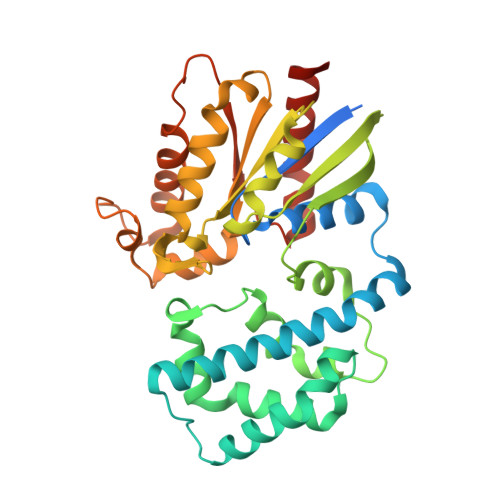A Conserved Phenylalanine as a Relay between the alpha 5 Helix and the GDP Binding Region of Heterotrimeric Gi Protein alpha Subunit.
Kaya, A.I., Lokits, A.D., Gilbert, J.A., Iverson, T.M., Meiler, J., Hamm, H.E.(2014) J Biol Chem 289: 24475-24487
- PubMed: 25037222
- DOI: https://doi.org/10.1074/jbc.M114.572875
- Primary Citation of Related Structures:
4PAM, 4PAN, 4PAO, 4PAQ - PubMed Abstract:
G protein activation by G protein-coupled receptors is one of the critical steps for many cellular signal transduction pathways. Previously, we and other groups reported that the α5 helix in the G protein α subunit plays a major role during this activation process. However, the precise signaling pathway between the α5 helix and the guanosine diphosphate (GDP) binding pocket remains elusive. Here, using structural, biochemical, and computational techniques, we probed different residues around the α5 helix for their role in signaling. Our data showed that perturbing the Phe-336 residue disturbs hydrophobic interactions with the β2-β3 strands and α1 helix, leading to high basal nucleotide exchange. However, mutations in β strands β5 and β6 do not perturb G protein activation. We have highlighted critical residues that leverage Phe-336 as a relay. Conformational changes are transmitted starting from Phe-336 via β2-β3/α1 to Switch I and the phosphate binding loop, decreasing the stability of the GDP binding pocket and triggering nucleotide release. When the α1 and α5 helices were cross-linked, inhibiting the receptor-mediated displacement of the C-terminal α5 helix, mutation of Phe-336 still leads to high basal exchange rates. This suggests that unlike receptor-mediated activation, helix 5 rotation and translocation are not necessary for GDP release from the α subunit. Rather, destabilization of the backdoor region of the Gα subunit is sufficient for triggering the activation process.
Organizational Affiliation:
From the Departments of Pharmacology.
















